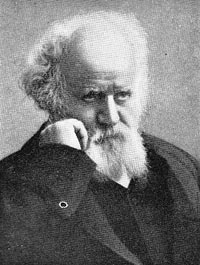Jules Janssen
Pierre Jules César Janssen (born February 22, 1824 in Paris , † December 23, 1907 in Meudon ) was a French astronomer . In 1868 he found a way to observe the solar corona even without a solar eclipse . In the same year he discovered an unknown element in the solar spectrum, the helium . The English astronomer Joseph Norman Lockyer succeeded in both at the same time - independently of Janssen .
resume
In 1853 Janssen taught at the Lycée Charlemagne . In 1857 he traveled to Peru to determine the magnetic equator . In 1859 he accompanied the natural scientist Alfred Grandidier on his world tour, but had to break it off after six months due to illness. From 1861 to 1862 and 1864 he studied the “telluric” lines in the solar spectrum and proved that they originate from the absorption of water vapor in the earth's atmosphere ( Latin tellus , earth ” ). From 1865 to 1871 Janssen taught in an architecture school. In 1867 he carried out optical and magnetic experiments in the Azores .
In 1868 Janssen showed the gaseous nature of the red solar corona and developed a method to observe it outside of the time of a solar eclipse. Norman Lockyer found such a method in the same year; a year later, William Huggins and Karl Friedrich Zöllner succeeded .
On August 18, 1868, a total solar eclipse was observed in India . It was observed by French astronomers, including Janssen, as well as British. At the same time, Norman Lockyer was watching the sun from London. During the evaluation, both discovered at about the same time, but independently of each other, a hitherto unknown element that was noticeable by a bright yellow line with a wavelength of 587.49 nanometers in the spectrum of the sun's chromosphere . Lockyer (and Edward Frankland ) suggested the name of this new element: helium . When Janssen made his discovery known, no one wanted to believe him at first, as no new element had ever been found in space before it could be discovered on earth.
In 1870 Janssen left besieged Paris in a balloon because he wanted to observe a solar eclipse in the Algerian city of Oran . In 1873 Janssen was elected to the Académie des sciences , 1901 to the National Academy of Sciences ; he had been a member of the Accademia dei Lincei in Rome since June 1872. In 1874 he traveled to Japan to observe the passage of Venus .
In order to document the passage of Venus, Janssen developed a "photographic revolver". With this clockwork device, he was able to record 48 recordings at one-second intervals on a ring-shaped plate. This “photographic revolver” inspired the French physiologist Étienne-Jules Marey to construct his “chronophotographic shotgun” with which objects moved in space - such as B. Birds in free flight - could be captured by line photography.
In 1875 Janssen was appointed director of the new astrophysical institute in Meudon (→ Paris Observatory ). In 1876 he achieved excellent solar photographs , which he published in 1904 in the Atlas de photographies solaires . In 1882 Janssen observed the passage of Venus in Oran. In 1887 he made solar observations on the Pic du Midi de Bigorre in the Pyrenees. In September 1893, he climbed Mont Blanc and stayed on the summit for four days to watch the sun. The aim was to find out whether the sun contained oxygen . In addition, near the was Observatory of Joseph Vallot , also an observatory on Mont Blanc built. In 1896 Janssen published the first part of the Annales de l'observatoire de Meudon .
Since 1875 Janssen was a foreign member of the Royal Society . In 1879 he was elected an Honorary Fellow of the Royal Society of Edinburgh . In 1904 he was accepted as a corresponding member of the Russian Academy of Sciences in Saint Petersburg .
Pierre Jules César Janssen died on December 23, 1907 at his place of work in Meudon.
Honors
In 1876 he was awarded the Rumford Medal by the Royal Society . The Mars crater Janssen as well as a moon crater Janssen were named in honor of Janssen. The same applies to Janssen Peak on Wiencke Island in Antarctica.
The Jules Janssen Prize ( Société astronomique de France ) and the Janssen Medal ( French Academy of Sciences ) are named after Pierre Jules César Janssen.
Solar eclipse expeditions
- 1867 Trani
- 1868 Guntur , India
- 1870 Algeria (the sky is overcast, observation is not possible)
- 1875 Siam
- 1883 Caroline Islands
- 1905 Alcosebre , Spain .
literature
- Françoise Launay: Un globe-trotter de la physique céleste. L'astronome Jules Janssen. Edition Vuibert, Paris 2008 ( [1] ).
Web links
- Publications by J. Janssen in the Astrophysics Data System
- Obituaries for J. Janssen in the Astrophysics Data System
- First corona observations without a solar eclipse (English; DOC file; 27 kB)
- Biography bibcode : 1991JBAA..101 ... 95K (English)
- Entry on Janssen, Pierre Jules Cesar (1824–1907) in the Archives of the Royal Society , London
Individual evidence
- ^ F. Paul Liesegang: Numbers and sources on the history of projection art and cinematography. Berlin 1926, p. 70.
- ^ Fellows Directory. Biographical Index: Former RSE Fellows 1783–2002. (PDF file) Royal Society of Edinburgh, accessed December 23, 2019 .
- ^ Foreign members of the Russian Academy of Sciences since 1724. Pierre Jules César Janssen. Russian Academy of Sciences, accessed August 31, 2015 (Russian).
| personal data | |
|---|---|
| SURNAME | Janssen, Jules |
| ALTERNATIVE NAMES | Janssen, Pierre Jules César (full name) |
| BRIEF DESCRIPTION | French astronomer |
| DATE OF BIRTH | February 22, 1824 |
| PLACE OF BIRTH | Paris |
| DATE OF DEATH | December 23, 1907 |
| Place of death | Meudon |

